How to Read ASVAB Scores — A Guide to Your ASVAB Score Range, ASVAB Line Scores, and Military ASVAB Score Requirements
Feb 15
/
Arsheena Mohamed
Embarking on the path to a distinguished career in the U.S. Armed Forces pivots on understanding a critical acronym: ASVAB. The Armed Services Vocational Aptitude Battery is more than a mere test—it's a gateway that evaluates your potential through ASVAB scores to determine your eligibility for enlistment and guide you toward the military roles best aligned with your abilities.
In this guide, we’ll cover
ASVAB Meaning
What is the ASVAB? It’s an acronym for Armed Services Vocational Aptitude Battery. If that sounds complicated, don't fret. In essence, the ASVAB is designed to assess your strengths across various areas to see if you're fit to serve — and where your talents would be best applied in the military.
ASVAB Line Scores vs Standard ASVAB Scores
Understanding your ASVAB test scores involves differentiating between standard ASVAB scores and ASVAB line scores. When reading your ASVAB test results, standard ASVAB scores describe your individual performance in each of the test's subcategories, which include:
| General Science (GS) | Arithmetic Reasoning (AR) |
| Word Knowledge (WK) | Paragraph Comprehension (PC) |
| Mathematics Knowledge (MK) | Electronics Information (EI) |
| Auto and Shop Information (AS) | Mechanical Comprehension (MC) |
| Assembling Objects (AO) | *New: Coding Speed (CS) |
(source: www.military.com)
These scores are presented as percentile rankings, ranging from 1 to 99, indicating how you fared compared to a normed group.
Composite scores, or ASVAB line scores, are combinations of these standard scores and directly relate to military job qualifications. Each branch of the military uses these composite scores to match you to potential roles.
For example, the Mechanical Maintenance (MM) line score, combining AS + MC + EI, could qualify you for technical positions. Whereas, the ASVAB General Technical (ASVAB GT) score, derived from WK + PC + AR, is often considered for more intellectually demanding roles.
For a more in depth breakdown of ASVAB line scores for each branch, check out our blog: What Jobs Do I Qualify for with My ASVAB Score?
Composite scores, or ASVAB line scores, are combinations of these standard scores and directly relate to military job qualifications. Each branch of the military uses these composite scores to match you to potential roles.
For example, the Mechanical Maintenance (MM) line score, combining AS + MC + EI, could qualify you for technical positions. Whereas, the ASVAB General Technical (ASVAB GT) score, derived from WK + PC + AR, is often considered for more intellectually demanding roles.
For a more in depth breakdown of ASVAB line scores for each branch, check out our blog: What Jobs Do I Qualify for with My ASVAB Score?
Understanding Your High School ASVAB Score Chart
When it comes to understanding how to read ASVAB scores, it's essential to identify the type of ASVAB score chart you're viewing.
The student version of the ASVAB, administered in schools, differs from the enlistment version typically given at Military Entrance Processing Stations (MEPS). The high school ASVAB scores reflect how your abilities compare to those of other students in your grade level.
You may receive something that looks like this:
The student version of the ASVAB, administered in schools, differs from the enlistment version typically given at Military Entrance Processing Stations (MEPS). The high school ASVAB scores reflect how your abilities compare to those of other students in your grade level.
You may receive something that looks like this:
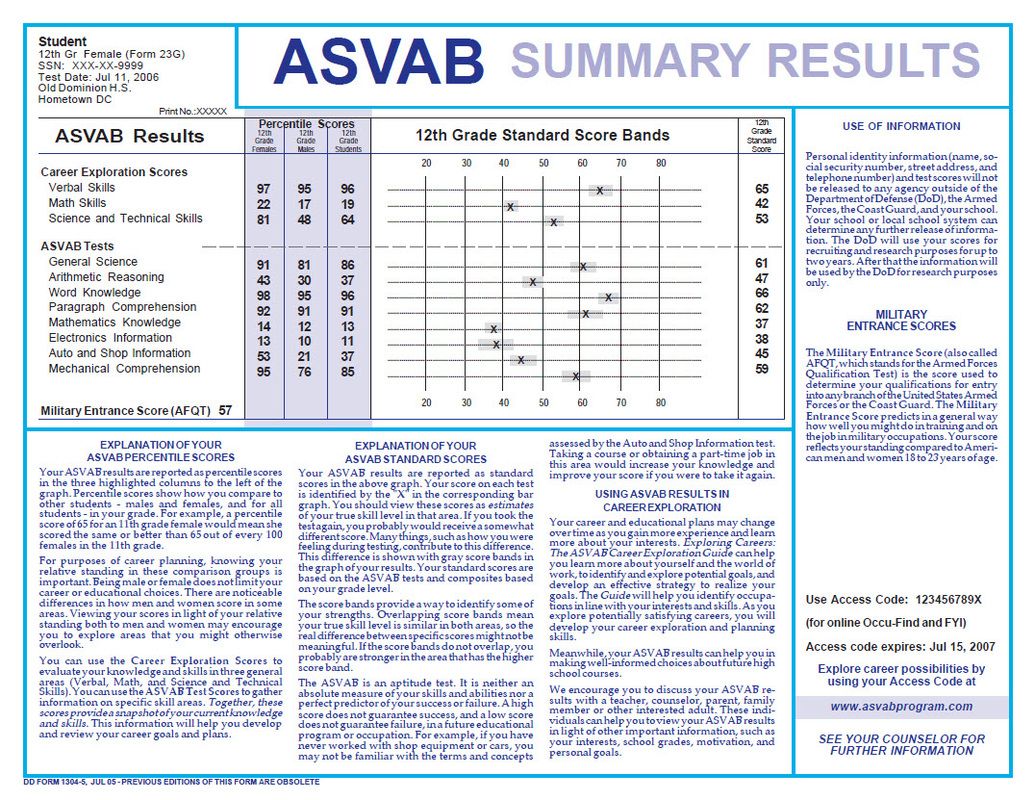
(https://awherleyhhsguidance.weebly.com/asvab.html)
Unless you know how to read your ASVAB score chart, it can get very confusing pretty fast so let's break it down into something that we can easily understand.
The image below zooms in on the areas you need to focus on. Let's read it from left to right starting with the highlighted area moving into each section after that.
The image below zooms in on the areas you need to focus on. Let's read it from left to right starting with the highlighted area moving into each section after that.
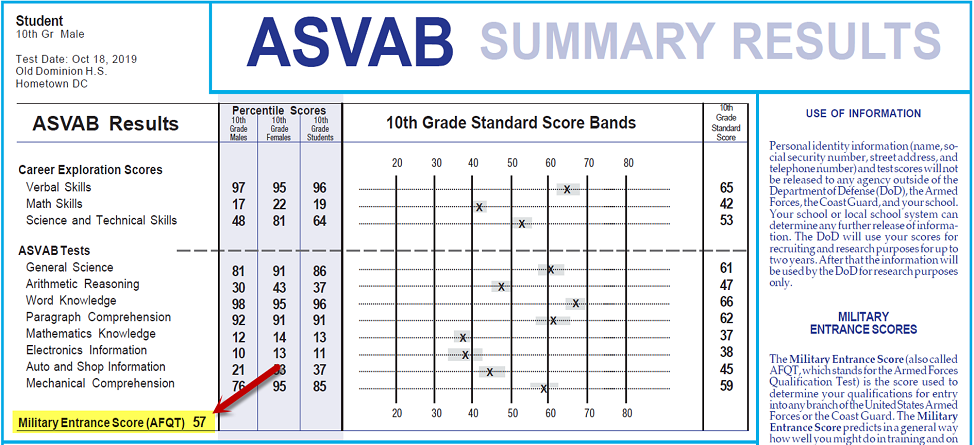
(https://www.asvabprogram.com/media-center-article/28)
Military Entrance Score (AFQT)
The AFQT score represents how well you've done in the core areas compared to a reference group of test-takers. For instance, an AFQT score of 57 means you did better than 57 percent of the people in the norm group.
- Army: Usually requires a minimum AFQT score of 31.
- Navy: Typically requires a minimum AFQT score of 35.
- Air Force: Often requires a minimum AFQT score of 36.
- Marine Corps: Generally requires a minimum AFQT score of 32.
- Coast Guard: Requires a higher AFQT score, with a minimum of 40.
It's important to note that these requirements can change based on the needs of the military and are sometimes waived for certain applicants with special skills or aptitudes.
Ultimately, your AFQT score will be the deciding factor in your qualification for enlistment. While ASVAB line scores determine the types of jobs you are eligible for, your AFQT score decides whether you're eligible to serve at all.
Percentile Scores
This next section is the highlighted columns directly to the right of your AFQT score.
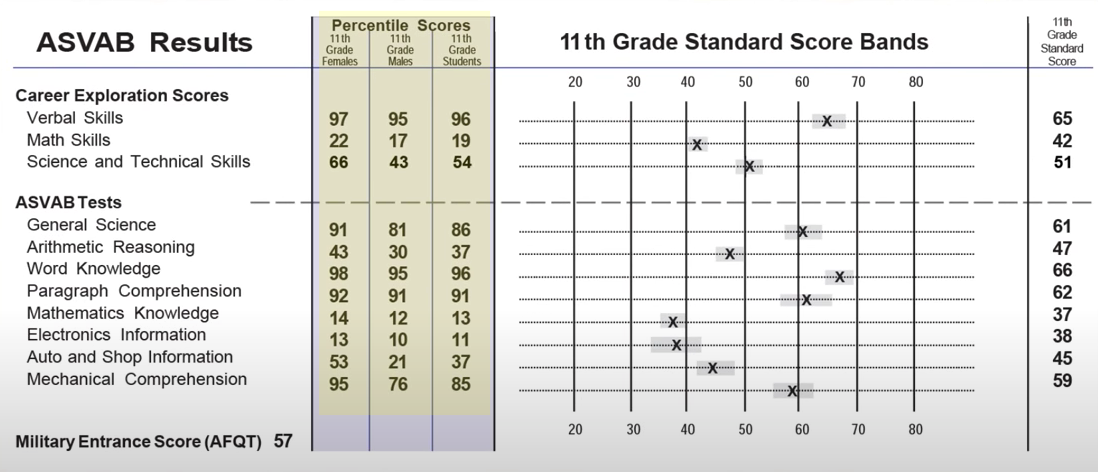
(https://www.asvabprogram.com/media-center-article/28)
In this section of the ASVAB score chart, you'll find columns that provide a detailed breakdown of your ASVAB percentile scores. These scores are pivotal in understanding how your results stack up against peers in your same grade level, as well as those of the opposite gender.
Again, it's important to note that these figures don't represent the percentage of questions you answered correctly. Instead, they reflect your standing within a percentile range from 1 to 99.
For instance, looking at Verbal Skills, the male student's score matches or surpasses 97 percent of 10th-grade males, 95 percent of 10th-grade females, and 96 percent of all students in his grade.
This comparative analysis is essential when contemplating what is a good ASVAB score or considering the highest possible ASVAB score one could achieve within their demographic.
Again, it's important to note that these figures don't represent the percentage of questions you answered correctly. Instead, they reflect your standing within a percentile range from 1 to 99.
For instance, looking at Verbal Skills, the male student's score matches or surpasses 97 percent of 10th-grade males, 95 percent of 10th-grade females, and 96 percent of all students in his grade.
This comparative analysis is essential when contemplating what is a good ASVAB score or considering the highest possible ASVAB score one could achieve within their demographic.
Standard Score Bands
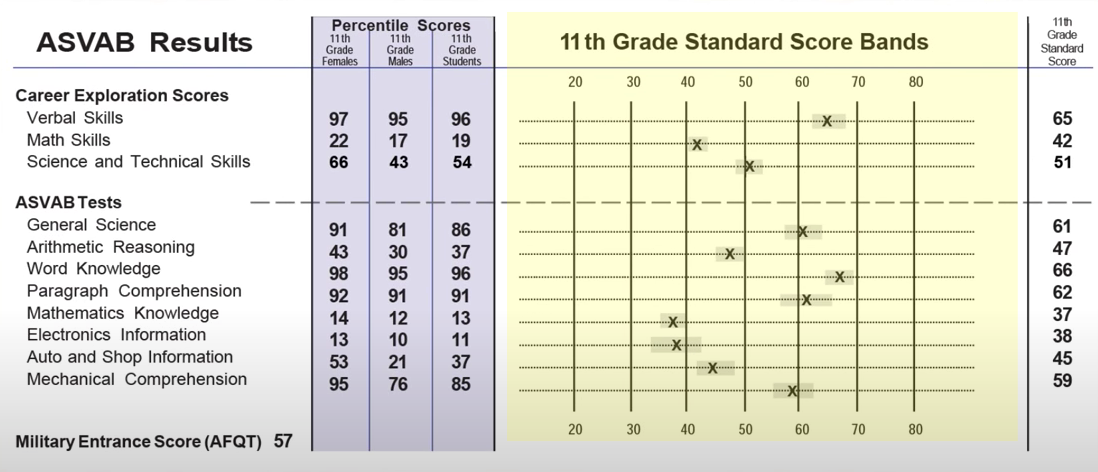
(https://www.asvabprogram.com/media-center-article/28)
In the next part of your ASVAB score chart, you might observe some gray shading enveloping each of your scores. In this example, it is the section labeled "10th Grade Standard Score Bands".
These shaded areas mark the ASVAB score ranges you are most likely to fall within should you decide to retake the test. This predictive feature offers a strategic insight into how to read ASVAB scores with an estimate of your potential improvement.
These shaded areas mark the ASVAB score ranges you are most likely to fall within should you decide to retake the test. This predictive feature offers a strategic insight into how to read ASVAB scores with an estimate of your potential improvement.
Standard Score
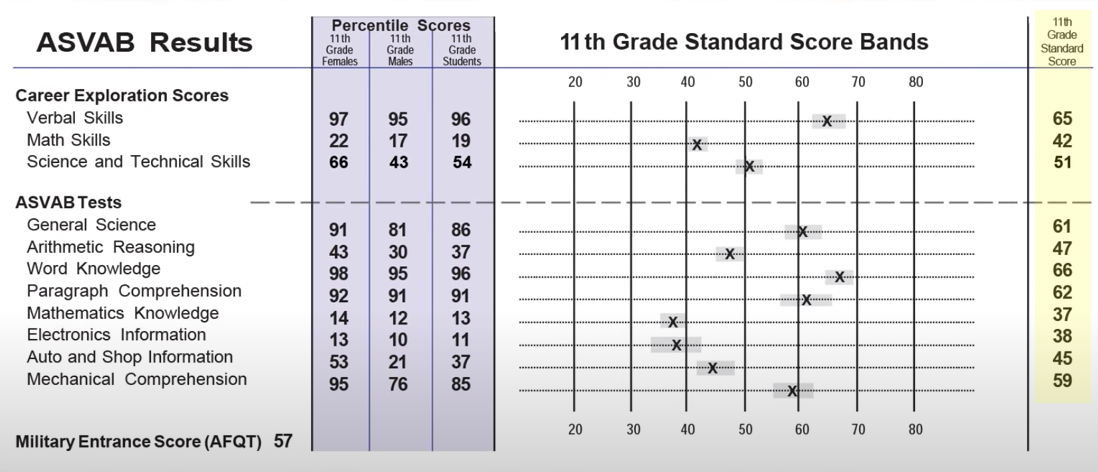
(https://www.asvabprogram.com/media-center-article/28)
The Standard Score can be found in the far-right column of the ASVAB score chart. This ASVAB score is calibrated against the national baseline of young adults within your grade level who have undertaken the ASVAB test.
When evaluating ASVAB standard scores, it's observed that a significant portion of test-takers typically achieve scores within the 30 to 70 range.
Consequently, attaining a Standard Score of 50 places you squarely in the average range, signifying your performance aligns with the median of national test results.
On the other hand, securing a score of 65 elevates you into the above-average tier, indicating a stronger aptitude in comparison to the average ASVAB scores of your peers.
When evaluating ASVAB standard scores, it's observed that a significant portion of test-takers typically achieve scores within the 30 to 70 range.
Consequently, attaining a Standard Score of 50 places you squarely in the average range, signifying your performance aligns with the median of national test results.
On the other hand, securing a score of 65 elevates you into the above-average tier, indicating a stronger aptitude in comparison to the average ASVAB scores of your peers.
Understanding Your Enlistment ASVAB Score Chart
Having delved into the specifics of ASVAB standard scores, the intricacies of ASVAB composite scores, and the crucial significance of the AFQT score, navigating the enlistment score chart should now be straightforward. This chart is the key to unlocking a clear path to your potential military career.
Your enlistment ASVAB score chart will look something like this:
Your enlistment ASVAB score chart will look something like this:
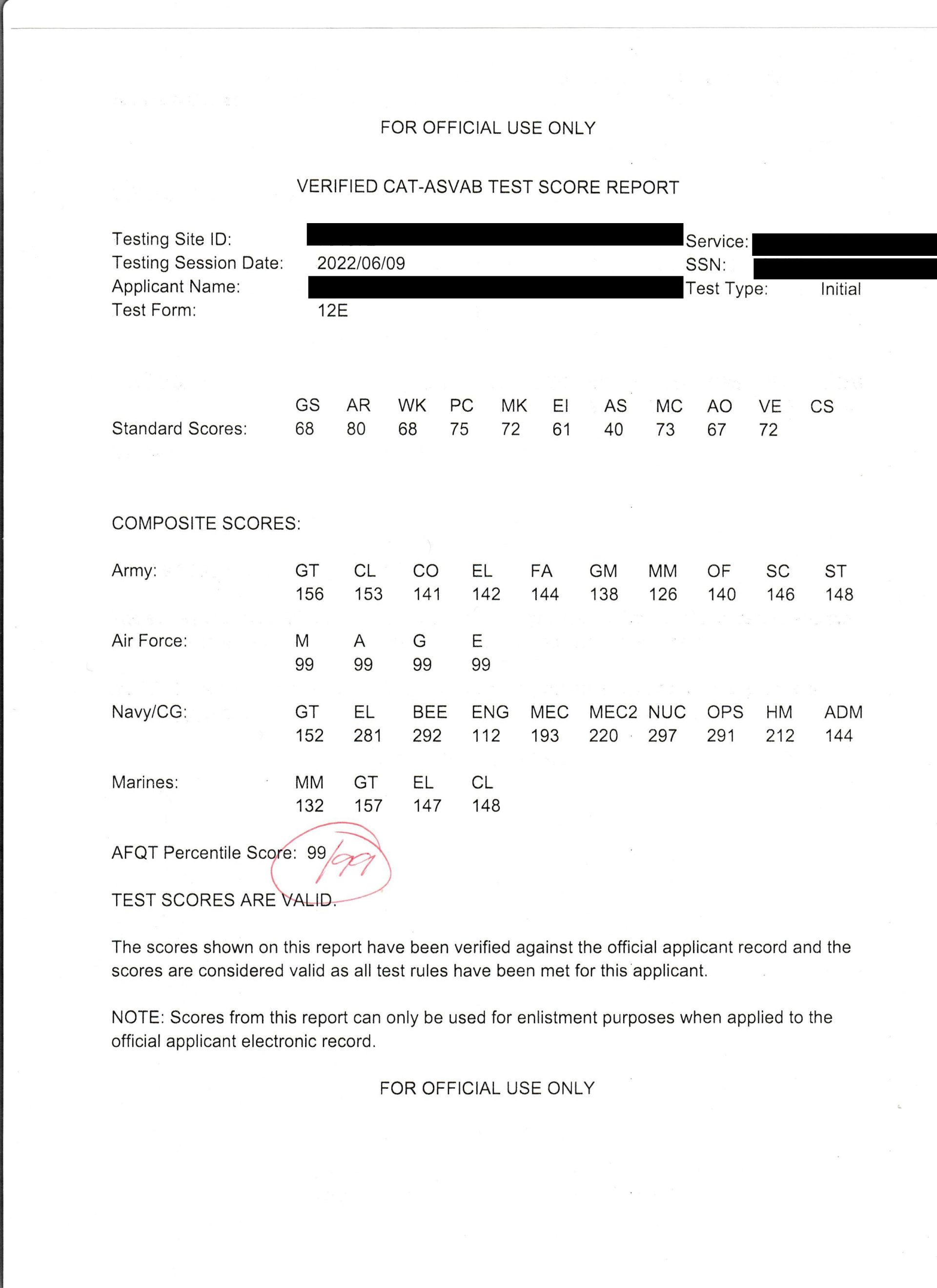
(https://www.reddit.com/r/army/comments/v8zzqs/99_asvab_today_please_help_me_understand_my_score/)
This ASVAB score chart is what you'll receive if you take the ASVAB test as an adult looking to start the enlistment process. You'll likely be taking the ASVAB at a testing center or at MEPS.
The enlistment score chart is designed to give you a comprehensive view, starting with your ASVAB standard scores in individual areas like Arithmetic Reasoning (AR) and Word Knowledge (WK), which highlight your specific skills.
The enlistment score chart is designed to give you a comprehensive view, starting with your ASVAB standard scores in individual areas like Arithmetic Reasoning (AR) and Word Knowledge (WK), which highlight your specific skills.
The chart then synthesizes these scores into ASVAB line scores, or composite scores, which military branches use to determine your suitability for various Military Occupational Specialties (MOS). For instance, a GT score in the Army may qualify you for different positions than a GT score in the Air Force, as each branch has unique requirements and roles.
At the chart's conclusion, your AFQT percentile score solidifies your eligibility for enlistment, serving as a definitive measure of how your performance stacks up against the larger applicant pool. It's this score that will ultimately open the doors to service, guiding you toward the branch and role where you can excel.
Check out more about the jobs you qualify for in each branch at our other blog: What Jobs Do I Qualify for with My ASVAB Score?
Check out more about the jobs you qualify for in each branch at our other blog: What Jobs Do I Qualify for with My ASVAB Score?
ASVAB Study Materials
8 out of 10 people fail the ASVAB on their first try.
Don’t let that be you. To increase your ASVAB scores, preparation is key. The right ASVAB study guides and materials can help you easily understand the test format, identify areas for improvement, and practice with ASVAB practice test questions.
Check out the following resources below that have helped former ASVAB students get the scores they want and the military jobs they deserve.
Don’t let that be you. To increase your ASVAB scores, preparation is key. The right ASVAB study guides and materials can help you easily understand the test format, identify areas for improvement, and practice with ASVAB practice test questions.
Check out the following resources below that have helped former ASVAB students get the scores they want and the military jobs they deserve.
Free ASVAB Study Resources
- Register for free online ASVAB classes and get a bonus online ASVAB practice test for free!
- Read Information ASVAB Blogs and Study Guides (Includes ASVAB Quizlet Flashcards)
- Watch fun and helpful ASVAB YouTube Videos by Duran Learning
- Join a free ASVAB Facebook group with 8,000 members and growing - weekly posts with practice problems, tips, and strategies
#1 Recommended ASVAB Classes and Practice
Our #1 Recommended ASVAB Resource - All-Access ASVAB Program
- Watch fun and easy-to-follow live classes (with 500+ recordings included)
- Practice with 25,000+ confidence-building practice test questions (video solutions and walkthroughs included)
- Keep track of what you've mastered and need to work on next with progress dashboards and weekly progress reports straight to your inbox!
Conclusion
After this read, hopefully you have a better understanding of how ASVAB scores are determined and how they can affect your military enlistment and career. No matter what ASVAB score chart you are reading, the ASVAB scores range from 1 to 99, with higher scores indicating a greater likelihood of qualifying for more specialized and advanced roles. Your ASVAB line scores can reveal the jobs within the military that align with your skill set, while your AFQT score — a subset of the ASVAB — decides your overall eligibility to serve.
What ASVAB score sheet are you looking at and how will your ASVAB score impact your military career choices?
For more ASVAB knowledge and test-taking tips, check out our other blog posts!
What ASVAB score sheet are you looking at and how will your ASVAB score impact your military career choices?
For more ASVAB knowledge and test-taking tips, check out our other blog posts!
More ASVAB Guides for You
The 5 Steps to Effective Learning
It's about quality, not quantity. Watch this video to learn how to learn fast AND confidently!
Write your awesome label here.
What's the Best Way to Focus?
It's not easy balancing studying for the ASVAB with all of your other commitments. Start here to make focusing and raising your score easy!
Write your awesome label here.
3 Simple Steps to Dominate Word Problems
There are 3 key steps to solving word problems!
- Identify the Question
- Use Keywords to Make a Plan
- Solve
Watch below to see how it works!
Write your awesome label here.
ASVAB Basics: The ASVAB, AFQT, PiCAT, and MEPS Explained
Learn the basics to the ASVAB and the related terms that you should know as an applicant.
Write your awesome label here.
Don't Fall for the Practice Test Trap
Redoing the same practice test over and over won't raise your score. Watch and learn how to use practice tests the RIGHT way.
Write your awesome label here.
Write your awesome label here.
Write your awesome label here.
Write your awesome label here.
Write your awesome label here.
Write your awesome label here.
Write your awesome label here.
Write your awesome label here.
Write your awesome label here.
Write your awesome label here.



